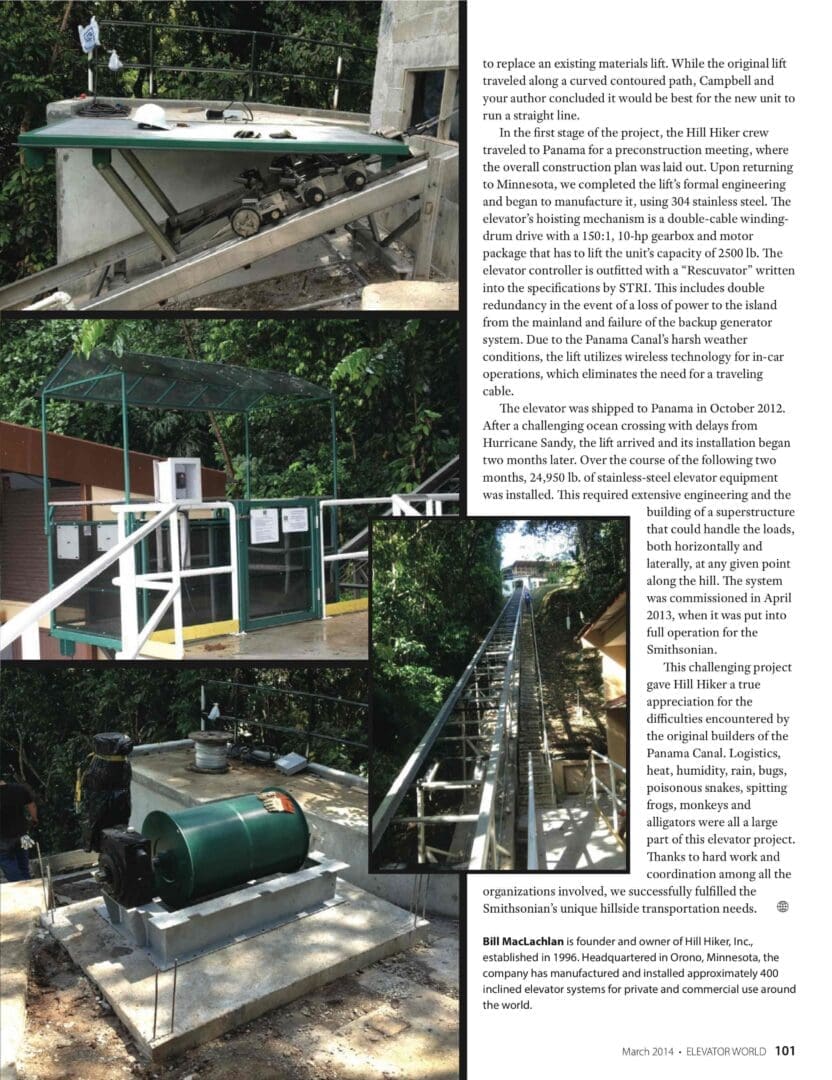Learn more about the Smithsonian Tropical Research Institute.
Learn more about Elevator World, the top trade magazine for the Elevator Industry.
(Note – Article text is also provided below article pages for easier reading on certain devices)


Jungle Tram
in the Panama Canal
by Bill MacLachlan
An inclined lift makes navigating the Smithsonian Tropical Research Institute’s unique layout possible.
The Smithsonian Tropical Research Institute (STRI) on Barro Colorado Island in the middle of the Panama Canal is a 90-year-old research facility for scientists and visitors from all over the world. Its tropical rainforest is considered an ideal environment in which to study the flora and fauna, in addition to the interaction between the commerce of the Panama Canal and jungle life.
In March 2012, Guglielmo R. Fiorina and Alfredo Alvarez of AMDEC, a Panama City-based elevator contractor, awarded Hill Hiker, Inc. a contract to work with them as manufacturer/supervisor of the 290-ft.-long stainless-steel, three-stop commercial inclined elevator project for STRI. This elevator serves both scientists and guests. Passengers enter at the lower stop, where the boats are docked. The scientists’ dormitories are located at the middle stop approximately 120 ft. up the hill, and the visitor center is 170 ft. from the dormitories at the third stop at the top of the hill.
Panamanian general contractor Jorge Campbell, owner of CONELSA, and your author, owner of Hill Hiker, worked together to determine the most efficient and cost-effective approach to building the new elevator. The Hill Hiker® Commercial Inclined Elevator was purchased to replace an existing materials lift. While the original lift traveled along a curved contoured path, Campbell and your author concluded it would be best for the new unit to run a straight line.
In the first stage of the project, the Hill Hiker crew traveled to Panama for a preconstruction meeting, where the overall construction plan was laid out. Upon returning to Minnesota, we completed the lift’s formal engineering and began to manufacture it, using 304 stainless steel. The elevator’s hoisting mechanism is a double-cable winding drum drive with a 150:1, 10-hp gearbox and motor package that has to lift the unit’s capacity of 2500 lb. The elevator controller is outfitted with a “Rescuvator” written into the specifications by STRI. This includes double redundancy in the event of a loss of power to the island from the mainland and failure of the backup generator system. Due to the Panama Canal’s harsh weather conditions, the lift utilizes wireless technology for in-car operations, which eliminates the need for a traveling cable.
The elevator was shipped to Panama in October 2012. After a challenging ocean crossing with delays from Hurricane Sandy, the lift arrived and its installation began two months later. Over the course of the following two months, 24,950 lb. of stainless-steel elevator equipment was installed. This required extensive engineering and the building of a superstructure that could handle the loads, both horizontally and laterally, at any given point along the hill. The system was commissioned in April 2013, when it was put into full operation for the Smithsonian.
This challenging project gave Hill Hiker a true appreciation for the difficulties encountered by the original builders of the Panama Canal. Logistics, heat, humidity, rain, bugs, poisonous snakes, spitting frogs, monkeys and alligators were all a large part of this elevator project. Thanks to hard work and coordination among all the organizations involved, we successfully fulfilled the Smithsonian’s unique hillside transportation needs.
Source:
MacLachlan, Bill. “Jungle Tram.” Elevator World, March 2014, pp. 100-101.









